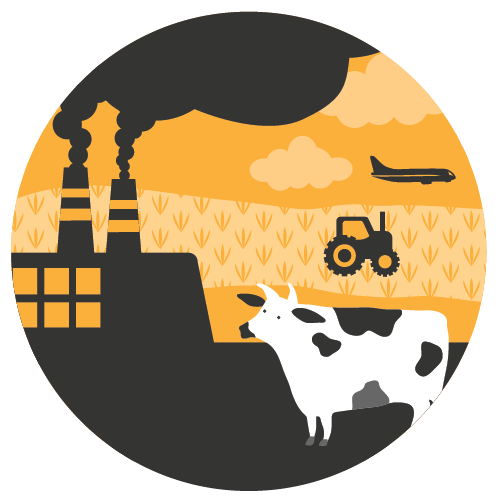THE GREENHOUSE EFFECT
The natural greenhouse effect is responsible for capturing the sun’s heat, making life on earth possible. Without the greenhouse effect, the earth’s temperature would be 18C colder than now.
Greenhouse gases are gases in Earth’s atmosphere that trap heat. They let sunlight pass through the atmosphere, they also prevent the heat that the sunlight brings from leaving the atmosphere.
Two-thirds of the natural greenhouse effect is caused by water vapor, circa one-third by carbon dioxide (CO2), and a little rest by other greenhouse gases (Methane, Ozone, Nitrous oxide, and Chlorofluorocarbons).
The amount of water vapor in the atmosphere is set by air temperatures. Unlike water vapor, the quantity of other greenhouse gases in the atmosphere can be directly modified by human activities.
Why is the Earth warming?
Global warming is the slow increase in the average temperature of the earth’s atmosphere. More and more of the sun’s energy is being trapped in the atmosphere and not radiated out into space.
This is happening because human activities are increasing the concentration of CO2 and other greenhouse gases, such as methane, and nitrous oxide, plus some chemically manufactured greenhouse gases such as halocarbons.
These human-generated gases enhance the natural greenhouse effect and further warm the surface.
CLIMATE SYSTEM & CLIMATE CHANGE
The global climate is the connected system of the sun, earth and oceans, wind, rain and snow, forests, deserts and savannas, and everything people do, too.
The components of the climate system are continually changing and interacting, as they are all open systems with the freedom to exchange mass and energy with one another.
The ocean-atmosphere system, for example, is a strongly coupled system exchanging water vapor and heat through evaporation. Water vapor increases as the Earth’s atmosphere warms, but so does the possibility of clouds and precipitation, making these some of the most important feedback mechanisms to the greenhouse effect.
The carbon cycle of the Earth is another system constantly influenced by humans through the burning of fossil fuels which emit greenhouse gases. The emission of greenhouse gases alters the balance of heat on the Earth, as it enhances the greenhouse effect which traps infrared radiation.
Forest act as a two-way highway, absorbing and storing CO2 when standing or regrowing and releasing it when cleared, burned or degraded.
The extension and complexity of these connections are what make global climate change a kind of abstract phenomenon, complicated and difficult to seize and visualize in our daily lives.
Observed changes in our climate system
The global warming of the past 50 years is primarily due to human activities.
Many of the impacts of climate change pose risks to human and natural systems, in the form of more frequent and severe heat waves, coastal inundation due to sea level rise, disruptions to rainfall patterns and other effects. Analyses of a range of climate scenarios indicate the most severe risks of climate change can largely be mitigated if carbon dioxide emissions are reduced to the point where carbon dioxide is no longer accumulating in the atmosphere.
Global climate is changing, and this change is apparent across a wide range of observations.

About this website
Hi, I’m Andrea, a Graphic and Web designer based in Germany.
This website is part of my graduation Master’s degree project (Audiovisual Arts Computer), where my research question was:
“How can designers and visual communicators contribute to transmit scientific knowledge and facts to a non-expert public in an understandable and relevant way, to generate awareness, motivate reflection and behavioral change.”
You can see the paper here:
Understanding climate change – Visual communication for scientific facts





